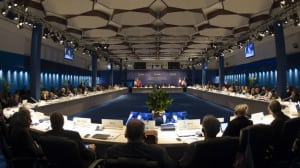ESA Hands Reins to Industry on New Launchers
[Via Satellite 12-03-2014] Describing the move as near revolutionary, Jean Jacques Dordain, director general of the European Space Agency (ESA), said the agency is changing the governance arrangements of Europe’s next generation launchers letting industry take the lead. ESA member states made several key decisions on the successors to the Ariane 5, Soyuz and Vega launchers at the 2014 Ministerial Council, chiefly to support the development of the Ariane 6 and Vega C as a new family of rockets that will have “the same DNA” at their core. But industry partners will take a primary position in drafting the next generation rockets.
“The relations between member states and industry have changed quite substantially with a different breakdown of risks and responsibilities and financing that we haven’t had so far,” Dordain said. “It is industry which will be taking on the responsibility of the commercial exploitation of these launchers. And for industry to be able to take that commercial risk, it will become the design authority, because one can’t imagine industry taking on the responsibility without having the design authority.”
European launch provider Arianespace has been a leader in the global launch business with more than 60 consecutive successful launches of the Ariane 5. According to ESA, the Ariane 5 rocket has drawn more than 50 percent of the world’s commercial market for launch services and has generated more than $60 billion in direct economic benefits for Europe. But new entrants — mainly SpaceX — have brought greater competitive pressure. ESA also anticipates satellites may trend down in mass as electric propulsion becomes more popular, so the agency wants to have launchers that evolve in tandem with satellites.
ESA hopes that shifting from three distinct launchers to two of the same family will save costs. The agency’s member states have agreed to fund the new rockets to completion by 2020. And for the next two years, ESA members decided to continue supporting existing European rockets. Dordain said there will be room for proposals on possible launcher evolution in 2015, ahead of a critical progress review the following year.
“Participating states will have to make a decision in 2016 on the basis of the results we would have had between now and then,” he said. “They will decide either to continue Ariane 6 on the same track or to change it once again, but we have commitments to take Ariane 6 to its maiden flight.”
ESA member states have agreed to launch five satellites per year with the Ariane 6 from 2021 to 2025. Dordain said between Galileo, Copernicus, the science programs of ESA and the meteorology programs of Eumetsat, there should be no doubt that there will be plenty of satellites to launch. Other launches are to come from the commercial market.
Development costs of approximately $5 billion have been agreed upon to support the Ariane 6, the Vega C, and the P120-C engine. ESA is currently planning two configurations of the Ariane 6: one with two P120 solid boosters (the A62) and another with four (A64). The P120 leverages technology from the existing Vega small satellite launcher.
“These changes always go hand in hand with fears and with resistance, but we have the will of member states on one hand, the will of industry on the other, and those two wills have come together [and] have overcome the resistance,” said Dordain.
Dordain added that Germany has agreed to fund the Vega C, bringing a common political makeup to Europe’s future launcher in addition to a common engineering makeup. In June, Airbus Defence and Space and Safran agreed to create a new joint venture that will lead the development of Europe’s next generation launch systems. Immediately after the Ministerial Conference, the two companies announced the joint venture will be named Airbus Safran Launchers and will start operations on Jan. 1, 2015 with a workforce of 450 people. Airbus and Safran’s proposal assumes an in-principle agreement for the transfer of shares in Arianespace held by the French space agency, the Centre National d’Etudes Spatiales (CNES), to the joint venture. ESA’s endorsement of the companies’ Ariane 6 proposal was critical to the joint venture’s formation.
